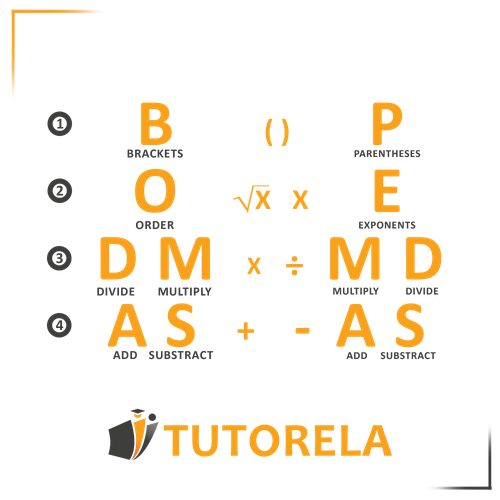How to Do an Exercise with Several Multiplications and Divisions
In cases when the exercise contains several multiplications and divisions, we solve them in order from left to right.
There are more rules concerning the order of operations when the exercise contains parentheses and powers, which is is covered in the following article:
Order of operations with parentheses and powers
Practical Examples: Addition and Subtraction
As we have learned, the last operations to perform are the additions and subtractions.
- Parentheses
- Powers and roots
- Multiplication and division
- Addition and subtraction
The order in which the operations are performed is the same even if combined operations with fractions appear. The addition and subtraction of fractions is the last operation to perform and is done in order from left to right.
Solve the following exercises using the order of operations:
Join Over 30,000 Students Excelling in Math!
Endless Practice, Expert Guidance - Elevate Your Math Skills Today
Basic Example 1
100−4+11−20=
Solve from left to right.
The first part of the exercise is 100−4, which is equal to 96.
Next is 96+11, which equals 107.
The last part of the exercise is 107−20, which is equal to 87.
Therefore, the final result is: 87.
Basic Example 2
20−2−3−8=
Solve from left to right.
The first part of the exercise is 20−2, which is equal to 18.
Then, if we solve 18−3 we get 15.
Finally, we solve the last part of the exercise: 15−8 equals 7.
Therefore, the final result is: 7.
Do you know what the answer is?
Multiplication and Division Exercises
Basic Example 3
10⋅2:4=
Solve from left to right.
First, we work out 10⋅2, which is equal to 20.
The next part of the exercise is solving 20:4, which is equal to 5.
The final result is: 5.
Basic Example 4
90:3:2:5=
Solve from left to right.
The first part of the exercise is solving 90:3, which equals: 30.
The next part of the exercise is solving 30:2, which is equal to 15.
Finally, we solve 15:5, which equals 3.
The final result is therefore: 3.
Example 5
72:2−3:1=
Solve from left to right (multiplication and division first, then addition and subtraction)
The multiplications and divisions of the exercise:
First, solve 72:2, which is equal to 36.
Then, the next part of the exercise is 3:1, which is equal to 3.
Giving us: 36−3.
Now perform the additions and subtractions of the exercise:
Now we perform 36−3, which is equal to 33.
Finally, the last part of the exercise is 33:1, which is equal to 33.
Therefore, the final result is: 33.
Example 6
300:3−20:2+3⋅4−2−7⋅3=
Solve from left to right (multiplication and division first, then addition and subtraction)
The multiplications and divisions of the exercise:
The first part of the exercise is 300:3, which equals 100.
Then we solve 20:2, which equals 10.
Next, we calculate 3⋅4, which equals 12.
Lastly, we solve 7⋅3, which equals 21.
Giving us: 100−10+12−2−21=.
The additions and subtractions of the exercise:
Then, we calculate 100−10, which is equal to 90.
The next part of the exercise is 90+12, which is equal to 102.
After that, we calculate 102−2, which equals 100.
The next part of the exercise is 100−21, which equals 79.
Finally, we calculate 100−21, which equals 79.
Therefore, the final result is: 79
Do you think you will be able to solve it?
Exercises for Practicing the Order of Operations
- 90−2+9−8=
- 40−3−5−9=
- 10⋅2:4=
- 80:4:2:5=
- 24:2:4−3:1=
- 5⋅5⋅2−12:4=
- 100:2−10:2+3⋅4−6−5⋅2=
Solutions
After solving the practice exercises, check your answers:
- R.89
- R.23
- R.5
- R.2
- R.0
- R.47
- R.41
If you liked this article, you may also be interested in the following articles:
On Tutorela , you can find a variety of useful articles about mathematics!
Review Questions
Why multiply before adding?
When we are asked to solve combined calculations where more than one operation appears, we must follow the order of operations. The order of operations dictates that we must must always perform multiplications first and then additions.
What is the order in which the mathematical operations are solved?
In general, when solving combined operations we must first solve the parentheses, then the powers and roots, then the multiplications and divisions, and finally the additions and subtractions.
Which is solved first when there are no parentheses, addition or multiplication?
In an operation without parentheses where addition and multiplication appear, we first solve the multiplications and then the additions.
Do you know what the answer is?
What is solved first in combined operations?
When we have combined operations, we must first solve the parentheses before solving the powers and roots.
What is the order of operations?
- Parentheses
- Powers and roots
- Left-to-right multiplication and division
- Addition and subtraction from left to right
What are the basic operations of mathematics?
The four basic operations are: addition, subtraction, multiplication and division.
Do you think you will be able to solve it?
Examples with solutions for Addition, Subtraction, Multiplication and Division
Exercise #1
10−3+7−5= ?
Video Solution
Step-by-Step Solution
According to the order of operations, solve the exercise from left to right since the only operations in it are addition and subtraction:
10−3=7
7+7=14
14−5=9
Answer
Exercise #2
90−2+9−8= ?
Video Solution
Step-by-Step Solution
According to the order of operations, we will solve the exercise from left to right since the only operations in it are addition and subtraction:
90−2=88
88+9=97
97−8=89
Answer
Exercise #3
−7+5+2+1=
Video Solution
Step-by-Step Solution
According to the rules of the order of arithmetic operations, we solve the exercise from left to right since it only has addition and subtraction operations:
−7+5=−2
−2+2=0
0+1=1
Answer
Exercise #4
Video Solution
Step-by-Step Solution
According to the rules of the order of arithmetic operations, we will work to solve the exercise from left to right:
9+3=11
11-1=10
And this is the solution!
Answer
Exercise #5
Video Solution
Step-by-Step Solution
According to the rules of the order of operations, given that the exercise only involves subtraction and addition operations, we solve the exercise from left to right:
3+2=5
5−1=4
Answer










